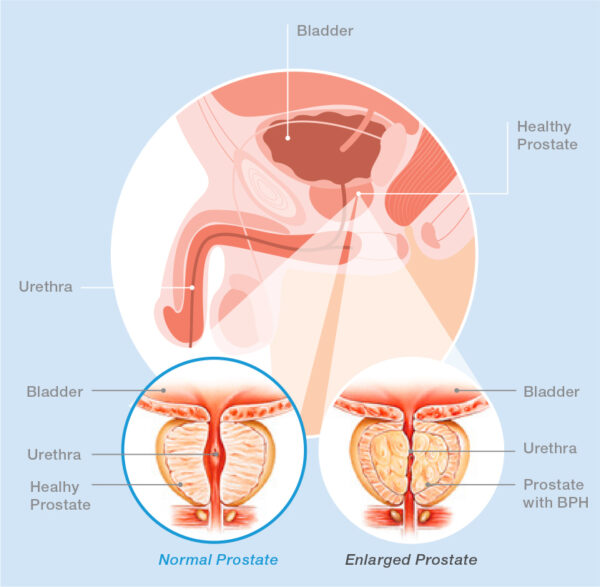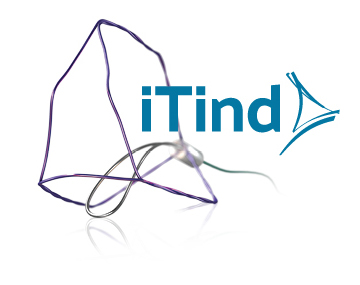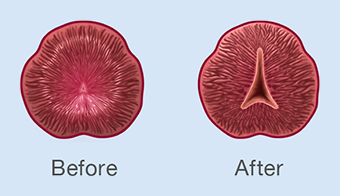The Prostate and Its Function
The prostate gland is a part of the male reproductive system that produces most of the seminal fluid. Normally, a prostate weighs about 20 grams and is the size of a walnut.
The prostate is located below the bladder and surrounds part of the urethra, a thin tube that transports urine from the body.
What Is BPH?

Top: Anatomy of the male reproductive system.
Bottom: Anatomy of an enlarged prostate gland. Arrows represent pressure on the urethra.
BPH stands for Benign Prostatic Hyperplasia, a non-cancerous condition.
Your prostate naturally enlarges as you get older—and that’s very common. In some men, as the prostate enlarges, it also puts pressure on the urethra3 and causes it to narrow, which can, in some cases, lead to a condition called BPH. This may cause some of the symptoms you’re experiencing now, such as:
- A sudden, frequent need to urinate
- Painful or difficulty urinating
- Reoccurring urinary tract infections
- Interruption of regular routines
- Interrupted sleep
- Inability to completely empty the bladder
- Lifestyle changes
What Is a Typical Treatment?
To treat enlarged prostates, doctors can choose from a variety of procedures.
Treatment options include:
- Drug therapy
- Watchful waiting
- Prostate reshaping
- Heat-based therapies
- Permanent implants
- Surgery - TURP (Transurethral Resection of the Prostate)
- Laser therapies
Many men choose drug therapy because it seems easy, but it comes with undesirable side effects and long-term lifestyle changes.
Prostate reshaping is a new in-office treatment for BPH patients seeking rapid symptom relief without permanent implants, painful heat-based therapies or daily prescription medications. Recovery is fast and patients are back to their normal lifestyle in no time.
Surgical TURP procedures are safe, deliver long-lasting results and have been proven to be the most effective BPH treatment. However, surgery may not suitable for all patients depending on their current situation.

iTind
iTind is a simple in-office procedure that can provide immediate results. Your urologist will place the iTind device in your prostate, using a cystoscope. Over the next 5-7 days, the device reshapes your prostate improving urine flow. At the end of the treatment period, iTind is completely removed. You'll go home without the need for a catheter and you should see results right away.
How Can iTind Reshape My Prostate?
iTind is a safe and effective treatment for symptoms of enlarged prostate (BPH) in men who have not found relief from drug therapy and are not yet ready for surgical therapy. The temporary implant reshapes the prostatic urethra to allow urine to flow better. iTind is a simple, in-office procedure that helps you quickly return to normal activity, without the need for continued BPH medications.

Why Choose iTind?

iTind is a simple in-office procedure that helps you quickly return to normal activity, without the need for continued BPH medications.
- Rapid symptom relief.3
- Return to your normal life fast
- Simple, straightforward in-office procedure
- Opens urethra without surgery
- Preserves sexual function.3
- Temporary implant, removed after only 5 days
- Specifically designed to be a catheter-free procedure.4,5
What Side Effects May I Notice?
Every medical treatment may have side effects. The same is true for iTind.
The potential side effects are:
- Blood in the urine
- Difficult or an urgent need to urinate
- Frequent urination or burning sensation
- Urinary tract infection
- You see large amounts of blood in your urine
- You have a temperature in excess of 101° F
- You experience chills or shaking
The risk for serious complications depends on your medical condition and age, as well as the experience of the surgeon. Ask your doctor what you should expect after surgery, as well as the potential risks that may occur with surgery.
Frequently Asked Questions
1. A. Roehrborn CG, McConnell JD, et al. AUA Guideline on the Management of Benign Prostatic Hyperplasia (BPH). Available at: http://www.auanet.org/content/guidelines-and-quality-care/ clinical-guidelines.cfm?sub=bph
2. American Urological Association, Benign Prostatic Hyperplasia. Available at: https://www.auanet.org/education/benign-prostatic-hypertrophy.cfm
3. Kadner, G., Valerio, M., Giannakis, I., Manit, A., Lumen, N., Ho, B. S., ... & Porpiglia, F. (2020). Second generation of temporary implantable nitinol device (iTind) in men with LUTS: 2 year results of the MT-02-study. World Journal of Urology, 1-10.
4. Srinivasan, A., & Wang, R. (2019). An Update on Minimally Invasive Surgery for Benign Prostatic Hyperplasia: Techniques, Risks, and Efficacy. The world journal of men’s health, 37.
5. Porpiglia, F., Fiori, C., Amparore, D., Kadner, G., Manit, A., Valerio, M., ... & Barber, N. (2019). Second‐generation of temporary implantable nitinol device for the relief of lower urinary tract symptoms due to benign prostatic hyperplasia: results of a prospective, multicentre study at 1 year of follow‐up. BJU international, 123(6), 1061-1069.
Olympus America Inc.


